When I was seven years old, I fell seriously ill and my folks took me to our family doctor for an examination. Dr. Davis correctly diagnosed me with Bulbar Polio. There was a very serious polio epidemic in the early 1950’s and many children my age were stricken with the disease. However, the development of the Salk vaccine in 1953 has nearly eradicated the polio virus.
Poliomyelitis polio, or infantile paralysis, acute viral infection, mainly of children but also affecting older persons. There are three immunologic types of poliomyelitis virus; exposure to one type produces immunity only to that type, so infection with the other types is still possible. Spread of the infection is primarily through contact with an infected person. Most people who contract polio either exhibit no symptoms or experience only minor illness; however, such individuals can harbor the virus and spread it to others. Less than 1% of the people who get infected develop paralysis.
The virus enters the body by way of the mouth, invades the bloodstream, and may be carried to the central nervous system, where it causes lesions of the gray matter of the spinal cord and brain. The illness begins with fever, headache, stiff neck and back, and muscle pain and tenderness. If there is involvement of the central nervous system, paralysis ensues. Of those patients who develop paralytic poliomyelitis, about 25% sustain severe permanent disability, another 25% have mild disabilities, and 50% recover with no residual paralysis. The disease is usually fatal if the nerve cells in the brain are attacked (bulbar poliomyelitis), causing paralysis of essential muscles, such as those controlling swallowing, heartbeat, and respiration. There is no specific drug for treatment. For reasons not clearly understood, some people who have had severe polio experience post-polio syndrome, a condition in which new weakness and pain occurs years later in previously affected muscles.
The poliovirus affected, in many different patterns, the nerve cells in the lower brain (bulbar) and spinal cord that control the muscles of the body. Poliovirus does not damage the lung tissue or the nerves to the airway muscle. When the bulbar nerves were destroyed (bulbar polio), the muscles of the throat were weakened. This resulted in choking during eating and a diminished ability to cough.
I was rushed directly from the doctor’s office to the
hospital and placed in an Iron Lung. Three children including myself were
admitted that evening, all of us placed in Iron Lungs. I didn’t know it at the
time, but my mother told me many years later that I was the only one of the
three that survived the night. That was my first brush with a near death experience.
There were a few more to come. The
following article from 1951 is from a local newspaper in New Jersey.
NJ, WESTFIELD, NEW JERSEY, SEPTEMBER 13, 1951
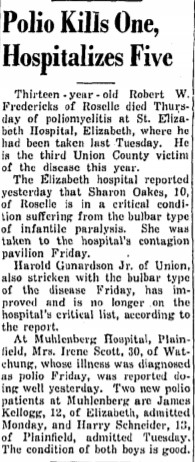
After writing this it occurred to me that today hardly anyone knows what an Iron Lung actually is or looks like. According to an article on Wikipedia in 2014 there were only ten people in the world still confined to iron lungs to keep them alive. There now are other more effective medical devices that substitute for the iron lung which facilitated breathing for victims of disease, causing breathing difficulties. The following article describes the device and a picture of one is shown below.
From Wikipedia:
The person using the iron lung is placed into the central chamber, a cylindrical steel drum. A door allowing the head and neck to remain free is then closed, forming a sealed, air-tight compartment enclosing the rest of the person’s body. Pumps that control airflow periodically decrease and increase the air pressure within the chamber, and particularly, on the chest. When the pressure is below that within the lungs, the lungs expand and atmospheric pressure pushes air from outside the chamber in via the person’s nose and airways to keep the lungs filled; when the pressure goes above that within the lungs, the reverse occurs, and air is expelled. In this manner, the iron lung mimics the physiological action of breathing: by periodically altering intra-thoracic pressure, it causes air to flow in and out of the lungs. The iron lung is a form of non-invasive therapy.
Iron Lung
When I turned sixty was when I first learned of the condition known as post-polio syndrome where all the symptoms of polio return. After a little research, I found the condition often affects polio survivors fifty years after they’ve recovered, most often between the ages of sixty to sixty-five. However, once a polio survivor gets past sixty-five without developing post-polio syndrome it is extremely unlikely to appear. I also learned there have never been any documented cases of a polio survivor that subsequently came down with Alzheimer’s. Well, that’s good news. I guess I can cross Post-Polio Syndrome a well as Alzheimer’s off the list of stuff that can still get me now.
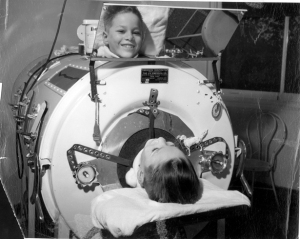
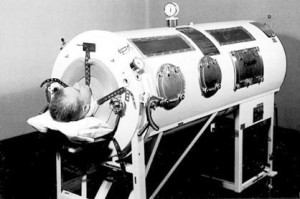
While I was in the hospital in recovery, my folks took me out for daily excursions in the city neighborhood around the hospital. One of the destinations we always stopped to window shop was a toy store that sold the common toys of the era as well as some very unusual high-end toys. One of these high-end toys was a very detailed model fire engine, a hook and ladder truck that was about three feet long. I was fascinated by the “hook and ladder” and always asked to stop to gaze at it in the store window on our neighborhood walks.
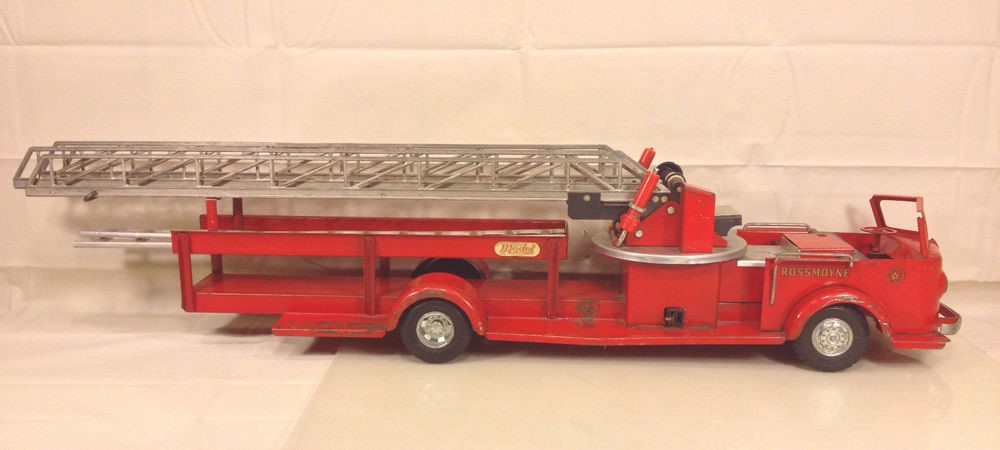
On the last week of my hospital stay just before I was released to return home my father came into my hospital room with a huge smile and large gift-wrapped box. When I opened the box, it was the “hook and ladder”. I still have the toy truck sixty-five years later! It is a little the worse for wear but still basically intact in the storage building at Jill’s house in Medford, New Jersey.
When I say it’s “a little worse for wear” that’s the result of an incident that occurred when Jim was about 4 or 5 years old. He was playing outside in the yard with several of his Tonka trucks as well as the “hook and ladder” fire engine. Suddenly, I noticed that he had several large stones and he was bombarding the fire engine with the stones ostensibly trying to destroy it. Naturally I was shocked, and my first instinct was to “give him hell”. However, I suddenly remembered when I was about the same age, I had a red peddle car that my father had given me as a Christmas gift. It looked a lot like this one.
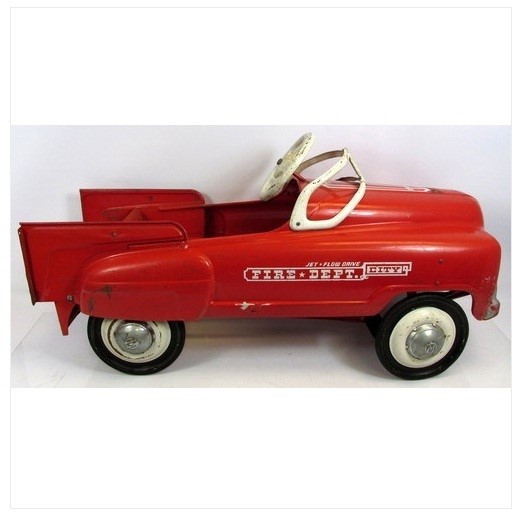
I loved that car and would frequently peddle it up and down the driveway and the sidewalk in front of the house. Suddenly one day for no rationale reason I found a large rock and started to throw it at the car trying to damage it and give a more of a weathered look. I don’t know why but I just felt compelled to do it. My mom saw what was going on and stopped me from destroying the thing. When I saw Jim attacking the fire engine it was like a flashback. I controlled myself and instead of hollering at him I just calmly put a stop to the destruction.
I recently attended a cookout with some friends and there was a young mother there with a 5-year-old boy. He was a cute happy kid full of energy, enthusiasm and curiosity but at the same time you instinctively knew he was a little devil. The yard was decorated for the Christmas cookout with crape paper decorations strung on the trees and bushes in the backyard. The next thing I noticed was little Jake with a rather large stick whacking the low hanging decorations off the trees and bushes. Once his mother noticed she immediately went over and took the stick away and firmly corrected him. Of course, predictably, fifteen minutes later he had another stick and was back at it and had be shut down again. You could see that there was no malice involved he just needed another correction, or distraction.
A little later I asked the mom, how old Jake was. She told me 5 and about to enter kindergarten the coming year. She then told me, “He has some developmental problems though.” A fellow about my age, grandpa status himself, spoke up and said, “No, he doesn’t. He’s just fine.” That was my thought exactly, boys will be boys, and we all have a certain innate instinct to just “blow stuff up from time to time.” It’s a male characteristic. It needs to be channeled properly and to a certain extent controlled. So, I saw a bit of my own childhood in Jake and I believe the grandpa beside me did as well.
Jake at his pre-kindergarten graduation. Now there’s a mischievous looking little devil if ever I saw one.

As the old Mother Goose nursery rhyme says. “What are little girls made of? Sugar and spice and everything nice; That’s what little girls are made of.” “What are little boys made of, made of? Snips and snails and puppy-dog tails; That’s what little boys are made of.”
The poem also has stanzas that cover what babies, young men, young women, sailors, soldiers, nurses, fathers, mothers, old men, old women and folks are made of. It is thought that Robert Southey wrote the stanzas about little boys and young women, but it is unclear who wrote the remaining stanzas. This poem, specifically the stanzas regarding little boys and little girls, is commonly found in the Mother Goose nursery rhyme collections.
After I was discharged from the hospital, which to the best of my recollection was several months later, there began a slow and tedious home bound recovery which took nearly a year. As a result, I missed that year of school, my third-grade year. However, my folks hired a tutor for my lessons so I could attend the fourth grade the following year and keep up with my classmates.
So long, good luck and have a nice day….